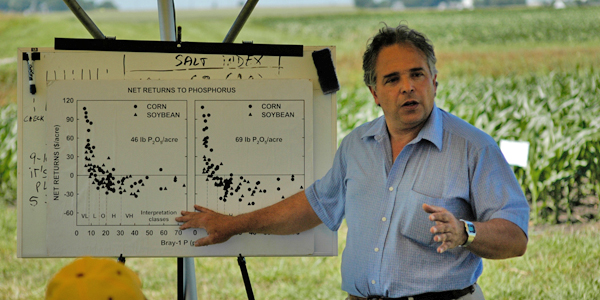
Growing More With Less
High yields don’t happen by accident. They demand a science-based approach to soil fertility and sustainable agronomic practices—key areas of research for Antonio Mallarino and John Sawyer.
“Iowa farmers are among the best in the world,” says Mallarino, a professor of soil fertility at Iowa State. “They love the land and are very good at helping me keep my feet on the ground, so my research is useful.”
His research helped create the Phosphorus Index in 2000. Developed for the Natural Resources Conservation Service, the Phosphorus Index was adopted by the Iowa Department of Natural Resources for nutrient management plans. The index offers a site-specific, farmer-friendly tool that balances cost-effective crop production with practical soil and water conservation practices, says John Lawrence, associate dean of extension and outreach in the College of Agriculture and Life Sciences.
“The Phosphorus Index allowed us to address regulatory pressure and environmental concerns and still allows us to farm,” says Lawrence, who notes other states look to Iowa State for guidance in creating similar tools for their farmers. “Iowa is a better place because of this work.”
The science and practice of agriculture remains a passion for Mallarino, who helped his father manage their family’s farm while he pursued his agronomy degree at the University of Uruguay. “I often think as a farmer first and a scientist second,” says Mallarino, who joined the faculty after earning his doctorate in crop production and physiology at Iowa State in 1988. “From the start, I’ve wanted to help farmers become more profitable while taking care of land and water resources.”
Roy Bardole farms with his sons Tim and Pete near Rippey, Iowa. They have assisted Mallarino with on-farm research, including a study to determine whether the deep placement of fertilizer in a strip-till system for soybean production works better than other application methods. “We need these kinds of real-world answers,” says Bardole, who has served on the American Soybean Association and the United Soybean Board. “Very few researchers around the globe have Antonio’s objectivity and commitment to benefiting local farmers.”
John Sawyer, professor of agronomy, shares this commitment to serving Iowa farmers. He is focused on providing farmers with cost-effective, appropriate agronomic practices, from nitrogen applications to soil conservation. When new research revealed that existing nitrogen recommendations were higher than necessary, Sawyer helped fine-tune nitrogen application guidelines in the mid-2000s for different states and different regions within states, including Iowa.
“Iowa farmers are receptive to new ideas,” says Sawyer, who has served as an extension soil fertility and nutrient management specialist since 1998. “We want to provide relevant research to address timely issues and help farmers find solutions.”
As farmers make crop nutrient decisions every year in the face of uncertain weather and market conditions, their decisions have important economic and environmental consequences, Lawrence adds. “The applied research and extension education by John and Antonio provide practical solutions to complex questions.”



